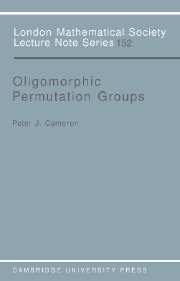4 - Subgroups
Published online by Cambridge University Press: 23 November 2009
Summary
BEGINNINGS
This chapter is about subgroups of automorphism groups of various structures.
There are several aspects to note. For a start, as we saw in Chapter 2, if a group G is the automorphism group of a structure, then it is the automorphism group of a homogeneous structure; and this is equivalent to G being a closed subgroup of the symmetric group. Describing all subgroups of the symmetric group is too wide a task, so I'll restrict both the structures, and the kinds of subgroups considered. As to the first, I shall consider only
(a) ℵ0-categorical structures (those whose automorphism groups are oligomorphic); and
(b) homogeneous structures whose age has the strong amalgamation property (those for which the stabiliser of a tuple in the automorphism group fixes no additional points).
Similar results hold in other cases; a notable example of this is provided by recursively saturated structures. (The results for these structures, due to Richard Kaye, were obtained following the Durham symposium.)
The results will in the main be constructions of subgroups with various properties, but at the end of the chapter I will describe some restrictive results characterising certain kinds of subgroups (normal subgroups, subgroups of small index, etc.).
There are differing levels of detail about a subgroup. We could be concerned with its structure as abstract group, as permutation group on some subset of the domain, or as permutation group on the entire domain.
Information
- Type
- Chapter
- Information
- Oligomorphic Permutation Groups , pp. 81 - 116Publisher: Cambridge University PressPrint publication year: 1990
